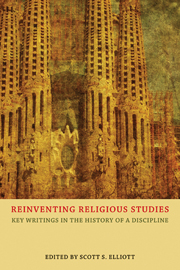Book contents
- Frontmatter
- Contents
- Introduction
- 1 For such a time as this: the Council of Societies for the Study of Religion, 1969–2009
- Part I Inventing and reinventing the field of religious studies
- 2 Why a Council on the Study of Religion?
- 3 Ironies
- 4 Religious studies: the next vocation
- 5 Impressions from Wingspread: religious studies—the state of the art
- 6 History of religions
- 7 The future of religious studies: moving beyond the mandate of the 1960s
- 8 Naming the game: a question of the field
- Part II Method and theory in religious studies
- Part III Teaching religion
- Part IV Women and the bible in religious studies
- Part V Religion and religious studies in civic life
- Part VI Religious studies and identity politics
- Part VII Islam and 9/11
- Bibliography
- Acknowledgments
- Index
7 - The future of religious studies: moving beyond the mandate of the 1960s
from Part I - Inventing and reinventing the field of religious studies
- Frontmatter
- Contents
- Introduction
- 1 For such a time as this: the Council of Societies for the Study of Religion, 1969–2009
- Part I Inventing and reinventing the field of religious studies
- 2 Why a Council on the Study of Religion?
- 3 Ironies
- 4 Religious studies: the next vocation
- 5 Impressions from Wingspread: religious studies—the state of the art
- 6 History of religions
- 7 The future of religious studies: moving beyond the mandate of the 1960s
- 8 Naming the game: a question of the field
- Part II Method and theory in religious studies
- Part III Teaching religion
- Part IV Women and the bible in religious studies
- Part V Religion and religious studies in civic life
- Part VI Religious studies and identity politics
- Part VII Islam and 9/11
- Bibliography
- Acknowledgments
- Index
Summary
In the emergent spiritual tradition God is not the personage of our Sunday-school mentality but more nearly the dimension described by William James. God is experienced as flow, wholeness, the infinite kaleidoscope of life and death. Ultimate Case, the ground of being … the consciousness that manifests as lila, the play of the universe.
(Ferguson 1980: 255)The United States is today undergoing a revival in religious belief and church attendance. The new interest in religion is multiple option. No one religious group claims a significant portion of the growth.
(Naisbitt 1982: 382)The Charismatics' emphasis on supernatural gifts over unceasing activity as proof of salvation represents a radical break from the traditional Protestant ethic. Scientific truths and concepts like technological efficiency, specialization and material accumulation begin to lose their religious justification when the signs of faith are suddenly transformed from “doing” to “being.”
(Rifkin 1979: 239–40)All the above passages constitute “observations” about the nature and prospects for religion in best-selling contemporary books by pop sociological gurus. Prognostications about where the public interest in religion is heading seem to be an obligatory feature of the new “futurist” literature which, in deference perhaps to the Star Wars and sci-fi obsessions of the 1980s, the national publishing houses have begun to promote with gusto. The accent in these specimens of vernacular eschatology—what might be dubbed the “trend as destiny” genre—is uniform.
- Type
- Chapter
- Information
- Reinventing Religious StudiesKey Writings in the History of a Discipline, pp. 51 - 55Publisher: Acumen PublishingPrint publication year: 2013



